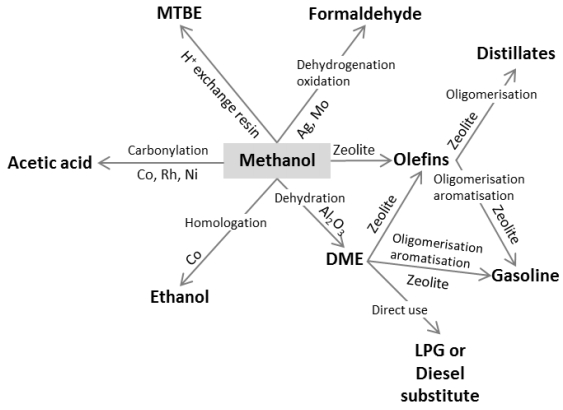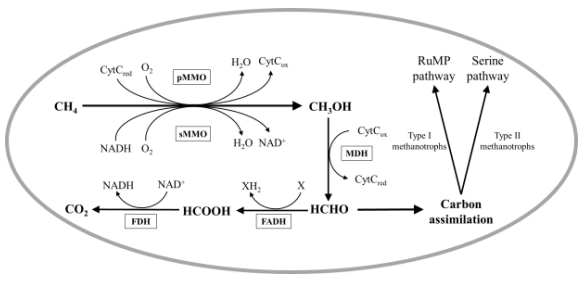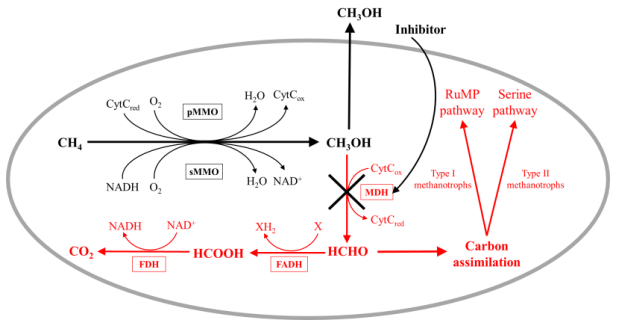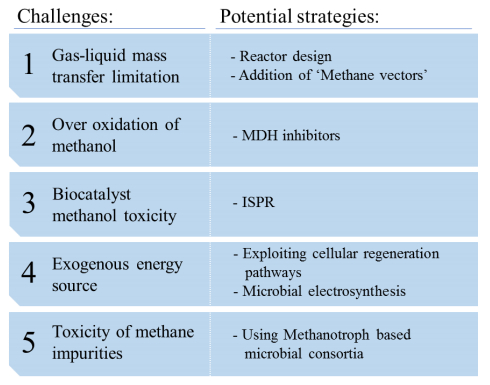Sources of methane are numerous, and vary greatly in their use and sustainable credentials. A Jekyll and Hyde character, it is a valuable energy source present as geological deposits of natural gas, however it is also potent greenhouse gas, released during many waste management processes. Gas-to-liquid technologies are being investigated as a means to exploit and monetise non-traditional and unutilised methane sources. The product identified as having the greatest potential is methanol due to it being a robust, commercially mature conversion process from methane and its beneficial fuel characteristics. Commercial methane to methanol conversion requires high temperatures and pressures, in an energy intensive and costly process. In contrast methanotrophic bacteria perform the desired transformation under ambient conditions, using methane monooxygenase (MMO) enzymes. Despite the great potential of these bacteria a number of biotechnical difficulties are hindering progress towards an industrially suitable process. We have identified five major challenges that exist as barriers to a viable conversion process that, to our knowledge, have not previously been examined as distinct process challenges. Although biotechnological applications of methanotrophic bacteria have been reviewed in part, no review has comprehensively covered progress and challenges for a methane to methanol process from an industrial perspective. All published examples to date of methanotroph catalysed conversion of methane to methanol are collated, and standardised to allow direct comparison. The focus will be on conversion of methane to methanol by whole-cell, wild type, methanotroph cultures, and the potential for their application in an industrially relevant process. A recent shift in the research community focus from a mainly biological angle to an overall engineering approach, offers potential to exploit methanotrophs in an industrially relevant biotechnological gas-to-liquid process. Current innovations and future opportunities are discussed.
1.
Introduction
Let $ \mathcal{A}_{p} $ denote the class of analytic and $ p $-valent functions $ f(z) $ with the next form
in the open unit disk $ \Delta = \{z\in\mathbb{C}: \mid z\mid < 1\} $.
For $ f\in\mathcal{A}_{p} $, its $ q $-derivative or the $ q $-difference $ \mathcal{D}_{q}f(z) $ is given by
where the $ q $-derivative operator $ \mathcal{D}_{q}f(z) $ (refer to [13] and [14]) of the function $ f $ is defined by
provided that $ f'(0) $ exists, and the $ q $-number $ [n]_{q} $ is just $ [\chi]_{q} $ when $ \chi = n\in\mathbb{N} $, here
Note that $ \mathcal{D}_{q}f(z)\longrightarrow f'(z) $ when $ q\longrightarrow1_{-} $, where $ f' $ is the ordinary derivative of the function $ f $.
Consider the generalized Bernardi integral operator $ \mathcal{J}^{\eta}_{p, q}:\mathcal{A}_{p}\longrightarrow\mathcal{A}_{p} $ with the next form
Then, for $ f\in\mathcal{A}_{p} $, we obtain that
where
Here we remark that if $ p = 1 $, it is exactly $ q $-Bernardi integral operator $ \mathcal{J}^{\eta}_{q} $ [21]. Further, if $ p = 1 $ and $ q\rightarrow1_{-} $, obviously it is the classical Bernardi integral operator $ \mathcal{J}_{\eta} $ [5]. In fact, Alexander [1] and Libera [18] integral operators are special versions of $ \mathcal{J}_{\eta} $ for $ \eta = 0 $ and $ \eta = 1 $, respectively.
For two analytic functions $ f $ and $ g $, if there exists an analytic function $ h $ satisfying $ h(0) = 0 $ and $ \mid h(z)\mid < 1 $ for $ z\in\Delta $ so that $ f(z) = g(h(z)) $, then $ f $ is subordinate to $ g $, i.e., $ f\prec g $.
Let $ \Lambda $ be the class of all analytic function $ \phi $ via the form
It is well known that the $ q $-calculus [13,14], even the $ (p, q) $-calculus [6], is a generalization of the ordinary calculus without the limit symbol, and its related theory has been applied into mathematical, physical and engineering fields (see [11,15,25]). Since Ismail et al.[12] firstly utilized the $ q $-derivative operator to investigate the $ q $-calculus of the class of starlike functions in disk, there had a great deal of work in this respect; for example, refer to Rehman et al. [24] for partial sums of generalized $ q $-Mittag-Leffler functions, Srivastava et al. [31] for Fekete-Szegö inequality for classes of $ (p, q) $-starlike and $ (p, q) $-convex functions and [27] for close-to-convexity of a certain family of $ q $-Mittag-Leffler functions, Seoudy and Aouf [26] for the coefficient estimates of $ q $-starlike and $ q $-convex functions and Uçar [33] for the coefficient inequality for $ q $-starlike functions. Besides, by involving some special functions and operators or increasing the complexity of function classes, many new subclasses of analytic functions associated with $ q $-calculus or $ (p, q) $-calculus were considered. Here we may refer to [9,23], Ahmad et al. [2] for convolution properties for a family of analytic functions involving $ q $-analogue of Ruscheweyh differential operator, Dweby and Darus [8] for subclass of harmonic univalent functions associated with $ q $-analogue of Dziok-Srivastava operator, Mahmmod and Sokól [20] for new subclass of analytic functions in conical domain associated with Ruscheweyh q-differential operator, Srivastava et al. [28] for coefficient inequalities for $ q $-starlike functions associated with the Janowski functions, [31] for Fekete-Szegö inequality for classes of $ (p, q) $-starlike and $ (p, q) $-convex functions using the $ q $-Bernardi integral operator and [32] for some results on the $ q $-analogues of the incomplete Fibonacci and Lucas polynomials. For the multivalent functions, Purohit [22] ever studied a new class of multivalently analytic functions associated with fractional $ q $-calculus operators, while Shi et al. [29] investigated the multivalent $ q $-starlike functions connected with circular domain. Moreover, Arif et al. [4] considered a $ q $-analogue of the Ruscheweyh type operator, and Srivastava et al. [30] dealt with basic and fractional q-calculus and associated Fekete-Szegö problems for $ p $-valently $ q $-starlike functions and $ p $-valently $ q $-convex functions of complex order using certain integral operators, and Khan et al. [17] for a new integral operator in $ q $-analog for multivalent functions. Stimulated by the previous results, in the paper we intend to introduce and investigate several new subclasses of $ q $-starlike and $ q $-convex type analytic and multivalent functions involving a generalized Bernardi integral operator, and establish the corresponding Fekete-Szegö type functional inequalities for these function classes. Besides, the corresponding bound estimates of the coefficients $ a_{p+1} $ and $ a_{p+2} $ are provided.
From now on we introduce some general subclasses of analytic and multivalent functions associated with the $ q $-derivative operator and the generalized Bernardi integral operator.
Definition 1.1. Let $ f(z)\in\mathcal{A}_{p} $ and $ \mu, \lambda\geq0 $. If the following subordination
is satisfied for $ z\in\Delta $, then we call that $ f(z) $ belongs to the class $ \mathcal{LN}^{\eta}_{p, q}(\mu, \lambda; \phi) $.
Definition 1.2. Let $ f(z)\in\mathcal{A}_{p} $ and $ 0\leq\lambda\leq1 $. If the following subordination
is satisfied for $ z\in\Delta $, then we call that $ f(z) $ belongs to the class $ \mathcal{LM}^{\eta}_{p, q}(\lambda; \phi) $.
Definition 1.3. Let $ f(z)\in\mathcal{A}_{p} $ and $ \mu\geq0 $. If the following subordination
is satisfied for $ z\in\Delta $, then we call that $ f(z) $ belongs to the class $ \mathcal{NS}^{\eta}_{p, q}(\mu; \phi) $.
Remark 1.4. If we put
or
in Definition (1.1–1.3), then the class $ \mathcal{LN}^{\eta}_{p, q}(\mu, \lambda; \phi) $ (res. $ \mathcal{LM}^{\eta}_{p, q}(\lambda; \phi) $ and $ \mathcal{NS}^{\eta}_{p, q}(\mu; \phi) $) reduces to $ \mathcal{LN}^{\eta}_{p, q}(\mu, \lambda; \alpha) $ (res. $ \mathcal{LM}^{\eta}_{p, q}(\lambda; \alpha) $ and $ \mathcal{NS}^{\eta}_{p, q}(\mu; \alpha) $) or $ \mathcal{LN}^{\eta}_{p, q}(\mu, \lambda; \beta) $ (res. $ \mathcal{LM}^{\eta}_{p, q}(\lambda; \beta) $ and $ \mathcal{NS}^{\eta}_{p, q}(\mu; \beta) $). Without the generalized Bernardi integral operator, the class $ \mathcal{LN}^{\eta}_{p, q}(\mu, \lambda; \phi) $ (res. $ \mathcal{LM}^{\eta}_{p, q}(\lambda; \phi) $ and $ \mathcal{NS}^{\eta}_{p, q}(\mu; \phi) $) is the classical function class $ \mathcal{LN}(\mu, \lambda; \phi) $ (res. $ \mathcal{LM}(\lambda; \phi) $ and $ \mathcal{NS}(\mu; \phi) $) when $ p = 1 $ and $ q\rightarrow1_{-} $.
Let $ \Omega $ be the class of functions $ \omega(z) $ denoted by
via the inequality $ \vert\omega(z)\vert < 1(z\in\Delta) $. Now we recall some necessary Lemmas below.
Lemma 1.5 ([16]). Let the function $ \omega\in\Omega $. Then
Specially, the sharp result holds for the next function
Lemma 1.6 ([7,10]). Let $ \mathcal{P} $ be the class of all analytic functions $ h(z) $ of the following form
satisfying $ \Re h(z) > 0 $ and $ h(0) = 1 $. Then there exist the sharp coefficient estimates $ \mid c_{n}\mid\leq2(n\in\mathbb{N}) $. In Particular, the equality holds for all $ n $ for the next function
Lemma 1.7 ([3,19]). Let the function $ \omega\in\Omega $. Then
For $ \kappa < -1 $ or $ \kappa > 1 $, the inequality holds literally if and only if $ \omega(z) = z $ or one of its rotations. If $ < \kappa < 1 $, the inequality holds literally if and only if $ \omega(z) = z^{2} $ or one of its rotations. In Particular, if $ \kappa = -1 $, then the sharp result holds for the next function
or one of its rotations. If $ \kappa = 1 $, then the sharp result holds for the next function
or one of its rotations. If $ -1 < \kappa < 1 $, then the upper bound is sharp as the followings
and
2.
Functional estimates for the class $ \mathcal{LN}^{\eta}_{p, q}(\mu, \lambda; \phi) $
By (1.9) we give that
In the section, with Lemma 1.5 we study Fekete-Szegö functional problem for the class $ \mathcal{LN}^{\eta}_{p, q}(\mu, \lambda; \phi) $ and provide the following theorem.
Theorem 2.1. Let $ \delta\in\mathbb{C} $. If $ f(z)\in\mathcal{A}_{p} $ belongs to the class $ \mathcal{LN}^{\eta}_{p, q}(\mu, \lambda; \phi) $, then
where
Moreover, the sharp result holds for the next function
Proof. Assume that $ f(z)\in\mathcal{LN}^{\eta}_{p, q}(\mu, \lambda; \phi) $. Then, from Definition 1.1, there exists an analytic function $ \omega(z)\in\Omega $ such that
Part case
Since
by (2.1) and (2.2) we see that
Thereby
and
Further, with (2.3) and (2.4) we obtain that
where
Therefore, according to Lemma 1.5 we finish the proof of Theorem 2.1.
Corollary 2.2. If $ f(z)\in\mathcal{A}_{p} $ belongs to the class $ \mathcal{LN}^{\eta}_{p, q}(\mu, \lambda; \phi) $, then
Moreover, the sharp result holds for the next function
When $ \phi\in\mathcal{P} $, combining (2.3) and (2.4) with Lemma 1.6 we instantly establish the next corollary for the coefficient bounds of $ a_{p+1} $ and $ a_{p+2} $.
Corollary 2.3. If $ f(z)\in\mathcal{A}_{p} $ belongs to the class $ \mathcal{LN}^{\eta}_{p, q}(\mu, \lambda; \phi) $, then
and
If we choose real $ \delta $ and $ \eta $, then by Lemma 1.7 we derive the next result for Fekete-Szegö problem.
Theorem 2.4. Let $ \delta, \eta\in\mathbb{R} $ and $ \phi\in\Lambda $ satisfying
If $ f(z)\in\mathcal{A}_{p} $ belongs to the class $ \mathcal{LN}^{\eta}_{p, q}(\mu, \lambda; \phi) $, then
where
and
Moreover, we take
Then, each of the following results is true:
(A) For $ \delta\in[\Upsilon_{1}, \Upsilon_{3}] $,
(B) For $ \delta\in[\Upsilon_{3}, \Upsilon_{2}] $,
where
Remark 2.5. Fixing the parameter $ p = 1 $ in Theorems 2.1 and 2.4, we can state the new results for the univalent function classes $ \mathcal{LN}^{\eta}_{1, q}(\mu, \lambda; \phi) = \mathcal{LN}^{\eta}_{q}(\mu, \lambda; \phi) $. As Remark 1.4, we may consider $ \mathcal{LN}^{\eta}_{p, q}(\mu, \lambda; \alpha) $ or $ \mathcal{LN}^{\eta}_{p, q}(\mu, \lambda; \beta) $ to establish latest results. On the other hand, for the different parameters $ \mu $ and $ \lambda $, we can deduce new results for $ \mathcal{LN}^{\eta}_{p, q}(\mu, \lambda; \phi) $.
3.
Functional estimates for the class $ \mathcal{LM}^{\eta}_{p, q}(\lambda; \phi) $
In the section we mainly consider Fekete-Szegö functional problem for the class $ \mathcal{LM}^{\eta}_{p, q}(\lambda; \phi) $ and establish the theorem as follows.
Theorem 3.1. Let $ \delta\in\mathbb{C} $. If $ f(z)\in\mathcal{A}_{p} $ belongs to the class $ \mathcal{LM}^{\eta}_{p, q}(\lambda; \phi) $, then
where
Moreover, the sharp result holds for the next function
Proof. If $ f\in\mathcal{LM}^{\eta}_{p, q}(\lambda; \phi) $, from Definition 1.2 there exists an analytic function $ \omega(z)\in\Omega $ such that
Part case
Since
by (2.1) and (3.1) we note that
and
Then, it leads to
and
Furthermore, in accordance with (3.2) and (3.3) we gain that
where
Thus, from Lemma 1.5 we give the Fekete-Szegö functional inequality in Theorem 3.1.
Corollary 3.2. If $ f(z)\in\mathcal{A}_{p} $ belongs to the class $ \mathcal{LM}^{\eta}_{p, q}(\lambda; \phi) $, then
Moreover, the sharp result holds for the next function
If $ \phi\in\mathcal{P} $, by (3.2) and (3.3) we take Lemma 1.6 to prove the next corollary for the coefficient bounds of $ a_{p+1} $ and $ a_{p+2} $.
Corollary 3.3. If $ f(z)\in\mathcal{A}_{p} $ belongs to the class $ \mathcal{LM}^{\eta}_{p, q}(\lambda; \phi) $, then
and
On the other hand, if we take real $ \delta $ and $ \eta $, then by Lemma 1.7 we give the next result for Fekete-Szegö problem.
Theorem 3.4. Let $ \delta, \eta\in\mathbb{R} $ and $ \phi\in\Lambda $ satisfying
If $ f(z)\in\mathcal{A}_{p} $ belongs to the class $ \mathcal{LM}^{\eta}_{p, q}(\lambda; \phi) $, then
where
and
Moreover, we choose
Then, each of the following results is true:
(A) For $ \delta\in[\Gamma_{1}, \Gamma_{3}] $,
(B) For $ \delta\in[\Gamma_{3}, \Gamma_{2}] $,
where
Remark 3.5. Similarly, by taking the parameter $ p = 1 $ in Theorems 3.1 and 3.4, we can obtain the new results for the univalent function classes $ \mathcal{LM}^{\eta}_{1, q}(\lambda; \phi) = \mathcal{LM}^{\eta}_{q}(\lambda; \phi) $. As Remark 1.4, we may consider $ \mathcal{LM}^{\eta}_{p, q}(\lambda; \alpha) $ or $ \mathcal{LM}^{\eta}_{p, q}(\lambda; \beta) $ to establish latest results. Clearly, for special parameter $ \lambda $, we can still imply new results for $ \mathcal{LM}^{\eta}_{p, q}(\lambda; \phi) $.
4.
Functional estimates for the class $ \mathcal{NS}^{\eta}_{p, q}(\mu; \phi) $
In the section we investigate Fekete-Szegö functional problem for the class $ \mathcal{NS}^{\eta}_{p, q}(\mu; \phi) $ and obtain the corresponding theorem below.
Theorem 4.1. Let $ \delta\in\mathbb{C} $. If $ f(z)\in\mathcal{A}_{p} $ belongs to the class $ \mathcal{NS}^{\eta}_{p, q}(\mu; \phi) $, then
where
Moreover, the sharp result holds for the next function
Proof. Since $ f\in\mathcal{NS}^{\eta}_{p, q}(\mu; \phi) $, from Definition 1.3 there exists an analytic function $ \omega(z)\in\Omega $ such that
Part case
Since
from (2.1) and (4.1) we know that
and
Thus it deduces that
and
Moreover, in the light of (4.2) and (4.3) we know that
where
Hence, in view of Lemma 1.5 we get the Fekete-Szegö functional inequality in Theorem 4.1.
Corollary 4.2. If $ f(z)\in\mathcal{A}_{p} $ belongs to the class $ \mathcal{NS}^{\eta}_{p, q}(\mu; \phi) $, then
Moreover, the sharp result holds for the next function
Once $ \phi\in\mathcal{P} $, together with (4.2) and (4.3) we apply Lemma 1.6 to prove the next corollary for the coefficient bounds of $ a_{p+1} $ and $ a_{p+2} $.
Corollary 4.3. If $ f(z)\in\mathcal{A}_{p} $ belongs to the class $ \mathcal{NS}^{\eta}_{p, q}(\mu; \phi) $, then
and
Clearly, if we let $ \delta $ and $ \eta $ be real, then from Lemma 1.7 we also show the following result for Fekete-Szegö problem.
Theorem 4.4. Let $ \delta, \eta\in\mathbb{R} $ and $ \phi\in\Lambda $ satisfying
If $ f(z)\in\mathcal{A}_{p} $ belongs to the class $ \mathcal{NS}^{\eta}_{p, q}(\mu; \phi) $, then
where
and
Moreover, we put
Then, each of the following results is true:
(A) For $ \delta\in[\Pi_{1}, \Pi_{3}] $,
(B) For $ \delta\in[\Pi_{3}, \Pi_{2}] $,
where
Remark 4.5. Similarly, by choose the parameter $ p = 1 $ in Theorems 4.1 and 4.4, we can provide the new results for the univalent function classes $ \mathcal{NS}^{\eta}_{1, q}(\mu; \phi) = \mathcal{NS}^{\eta}_{q}(\mu; \phi) $. As Remark 1.4, we may consider $ \mathcal{NS}^{\eta}_{p, q}(\mu; \alpha) $ or $ \mathcal{NS}^{\eta}_{p, q}(\mu; \beta) $ to establish latest results. Besides, for the fixed parameter $ \mu $, we can still infer new results for $ \mathcal{NS}^{\eta}_{p, q}(\mu; \phi) $.
5.
Conclusion
By involving a generalized Bernardi integral operator, several new subclasses of $ q $-starlike and $ q $-convex type analytic and multivalent functions are introduced to generalize the classical starlike and convex functions. Meanwhile, for these classes we may know integral operator and $ q $-derivative as well as multivalency how to change the coefficients of functions. In our main results, we establish the Fekete-Szegö type functional inequalities for these function classes. Further, the corresponding bound estimates of the coefficients $ a_{p+1} $ and $ a_{p+2} $ are interpreted. In fact, if we use the other integral operators or take $ (p, q) $-operator when certain function is univalent but not multivalent, we may get many similar results as in this article.
Acknowledgments
We thank the referees for their careful readings and using comments so that this manuscript is greatly improved. This work is supported by Institution of Higher Education Scientific Research Project in Ningxia of the People's Republic of China under Grant NGY2017011, Natural Science Foundation of Ningxia of the People's Republic of China under Grant 2020AAC03066, the Program for Young Talents of Science and Technology in Universities of Inner Mongolia Autonomous Region under Grant NJYT-18-A14, the Natural Science Foundation of Inner Mongolia of the People's Republic of China under Grant 2018MS01026, the Natural Science Foundation of the People's Republic of China under Grant 11561001, 42064004 and 11762016.
Conflict of interest
The authors declare no conflict of interest.



















 DownLoad:
DownLoad: